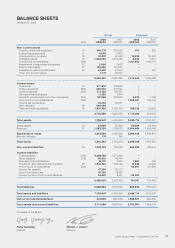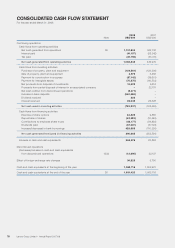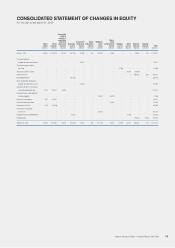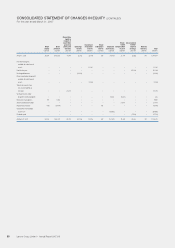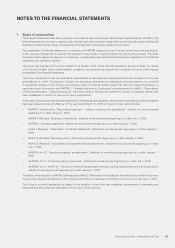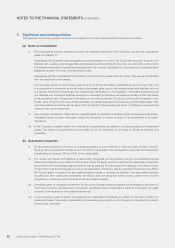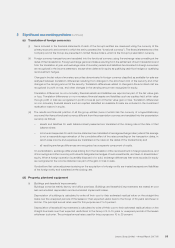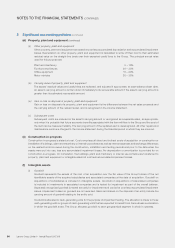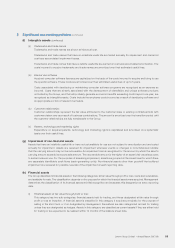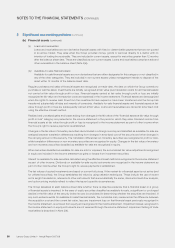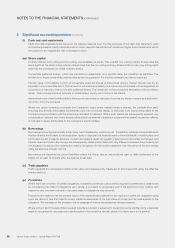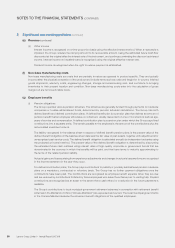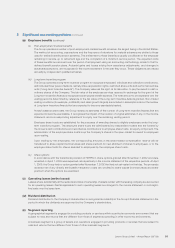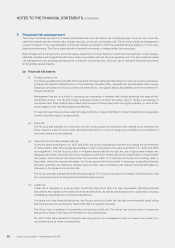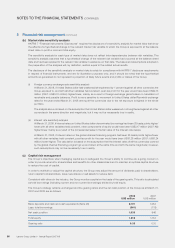Lenovo 2008 Annual Report Download - page 88
Download and view the complete annual report
Please find page 88 of the 2008 Lenovo annual report below. You can navigate through the pages in the report by either clicking on the pages listed below, or by using the keyword search tool below to find specific information within the annual report.
NOTES TO THE FINANCIAL STATEMENTS (CONTINUED)
2 Significant accounting policies (continued)
(h) Financial assets (continued)
(ii) Loans and receivables
Loans and receivables are non-derivative financial assets with fixed or determinable payments that are not quoted
in an active market. They arise when the Group provides money, goods or services directly to a debtor with no
intention of trading the receivable. They are included in current assets, except for maturities greater than 12 months
after the balance sheet date. These are classified as non-current assets. Loans and receivables comprise trade and
other receivables in the balance sheet (Note 2(k)).
(iii) Available-for-sale financial assets
Available-for-sale financial assets are non-derivatives that are either designated in this category or not classified in
any of the other categories. They are included in non-current assets unless management intends to dispose of the
asset within 12 months of the balance sheet date.
Regular purchases and sales of financial assets are recognized on trade-date, the date on which the Group commits to
purchase or sell the asset. Investments are initially recognized at fair value plus transaction costs for all financial assets
not carried at fair value through profit or loss. Financial assets carried at fair value through profit or loss are initially
recognized at fair value and transaction costs are expensed in the income statement. Financial assets are derecognized
when the rights to receive cash flows from the investments have expired or have been transferred and the Group has
transferred substantially all risks and rewards of ownership. Available-for-sale financial assets and financial assets at fair
value through profit or loss are subsequently carried at fair value. Loans and receivables are carried at amortized cost
using the effective interest method.
Realized and unrealized gains and losses arising from changes in the fair value of the “financial assets at fair value through
profit or loss” category are presented in the income statement in the period in which they arise. Dividend income from
financial assets at fair value through profit or loss is recognized in the income statement as part of other income when
the Group’s right to receive payments is established.
Changes in the fair value of monetary securities denominated in a foreign currency and classified as available-for-sale are
analyzed between translation differences resulting from changes in amortized cost of the security and other changes in
the carrying amount of the security. The translation differences on monetary securities are recognized in profit or loss,
while translation differences on non-monetary securities are recognized in equity. Changes in the fair value of monetary
and non-monetary securities classified as available-for-sale are recognized in equity.
When securities classified as available-for-sale are sold or impaired, the accumulated fair value adjustments recognized
in equity are included in the income statement as gains or losses from investment securities.
Interest on available-for-sale securities calculated using the effective interest method is recognized in the income statement
as part of other income. Dividends on available-for-sale equity instruments are recognized in the income statement as
part of other income when the Group’s right to receive payments is established.
The fair values of quoted investments are based on current bid prices. If the market for a financial asset is not active (and
for unlisted securities), the Group establishes fair value by using valuation techniques. These include the use of recent
arm’s length transactions, reference to other instruments that are substantially the same, discounted cash flow analysis,
and option pricing models refined to reflect the issuer’s specific circumstances.
The Group assesses at each balance sheet date whether there is objective evidence that a financial asset or a group
of financial assets is impaired. In the case of equity securities classified as available-for-sale, a significant or prolonged
decline in the fair value of the security below its cost is considered in determining whether the securities are impaired. If
any such evidence exists for available-for-sale financial assets, the cumulative loss, measured as the difference between
the acquisition cost and the current fair value, less any impairment loss on that financial asset previously recognized in
the income statement, is removed from equity and recognized in the income statement. Impairment losses recognized in
the income statement on equity instruments are not reversed through the income statement. Impairment testing of trade
receivables is described in Note 2(k).
Lenovo Group Limited • Annual Report 2007/08
86



